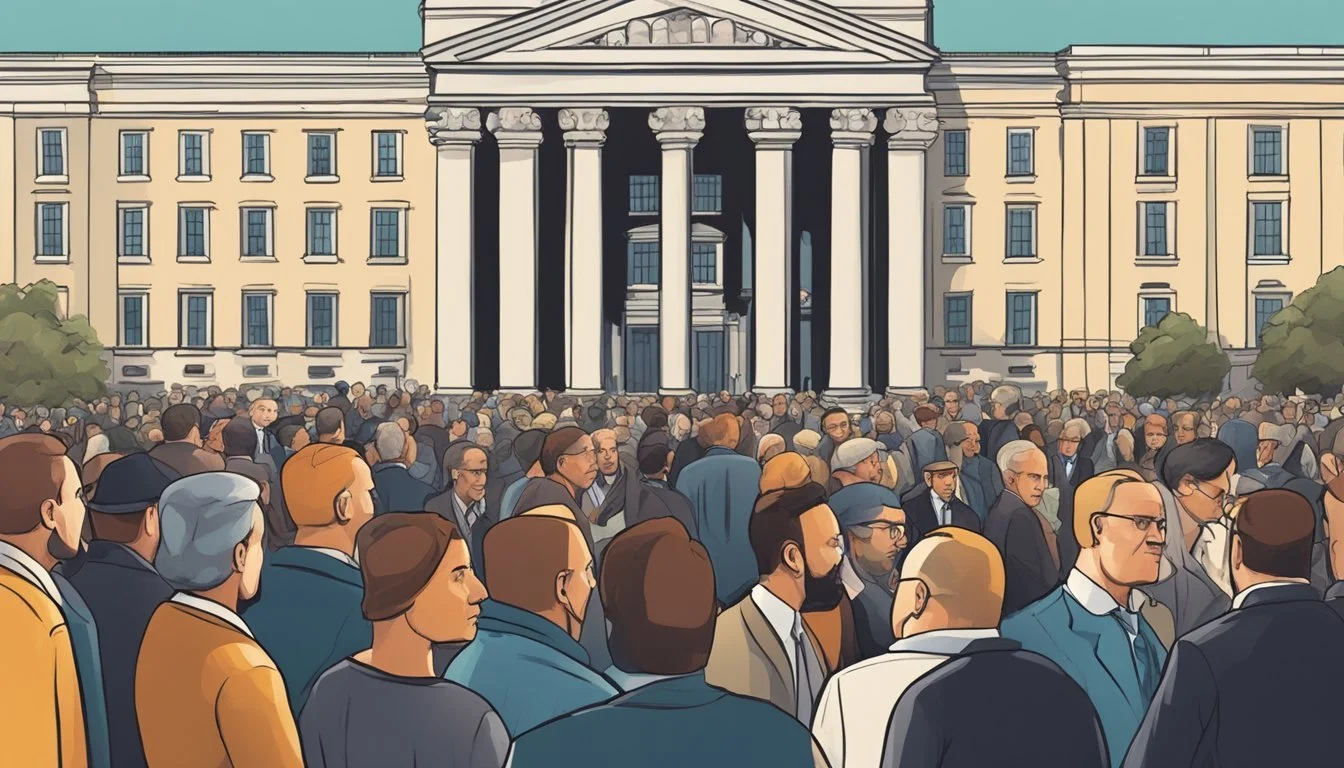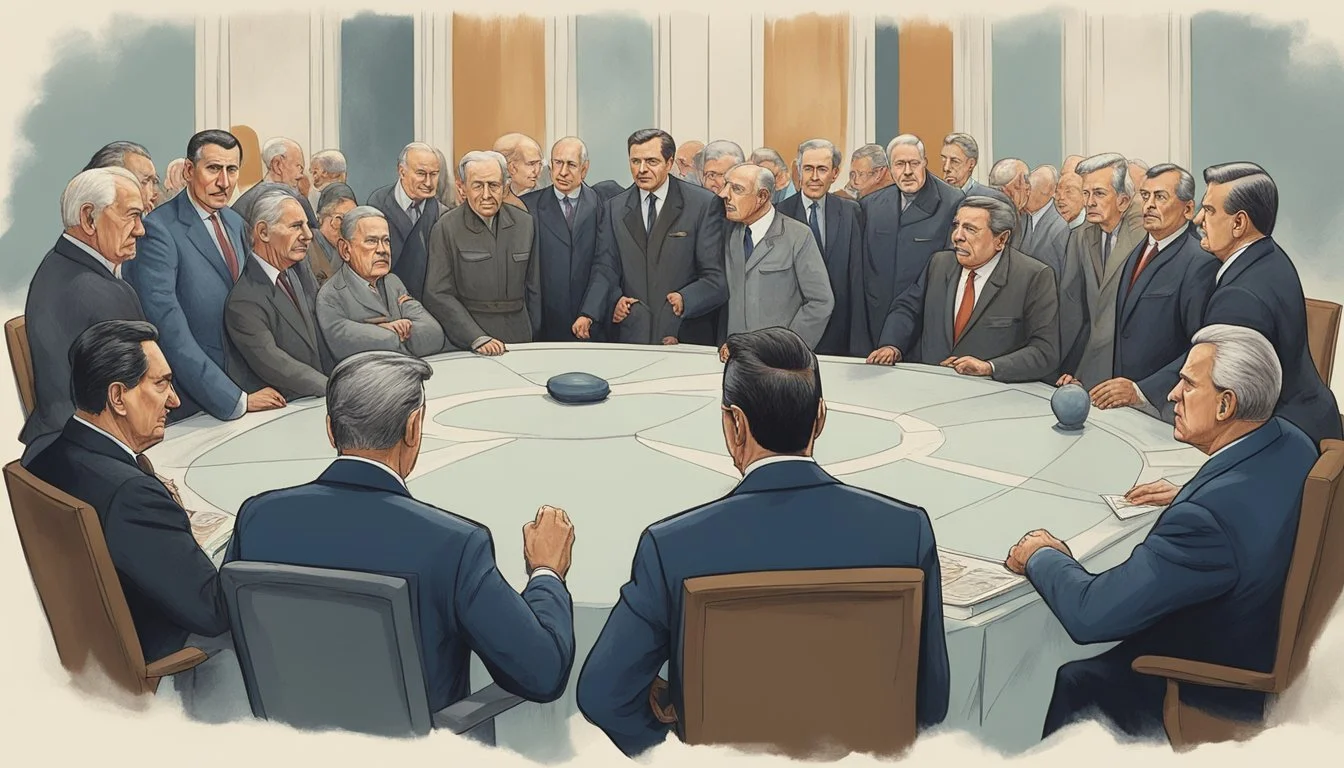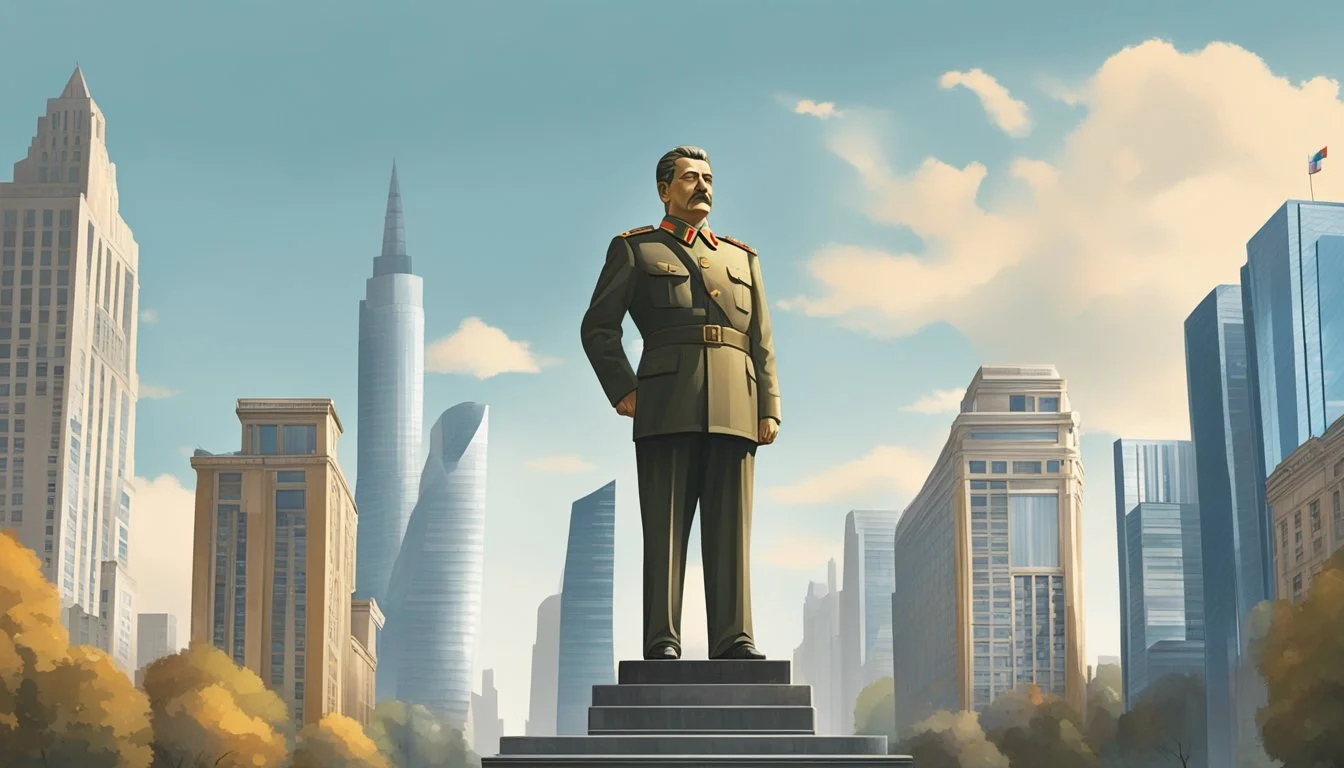After Stalin: The Real Power Struggle That Inspired 'The Death of Stalin'
Unveiling the Kremlin's Tumultuous Transition
Joseph Stalin's death on March 5, 1953 plunged the Soviet Union into a period of intense political turmoil. As the authoritarian leader who had ruled with an iron fist for nearly three decades lay dead, a cutthroat scramble for power ensued among his top lieutenants. The subsequent events inspired the dark comedy film "The Death of Stalin," which drew from the bizarre and sometimes darkly humorous real-life power struggle that followed Stalin's demise.
With no clear succession plan in place, prominent figures like Nikita Khrushchev, Georgy Malenkov, and Lavrentiy Beria vied for control of the Soviet state. The power vacuum created opportunities for ambitious officials to outmaneuver rivals through political maneuvering, alliances, and even violence. This chaotic period saw rapid shifts in leadership and policy as different factions gained and lost influence.
The post-Stalin succession crisis had far-reaching consequences for the Soviet Union and the Cold War. It led to significant changes in Soviet domestic and foreign policy under new leadership. The events surrounding Stalin's death and its aftermath continue to fascinate historians and the public, shedding light on the inner workings of the secretive Soviet regime during a pivotal moment in 20th century history.
The Final Days of Joseph Stalin
Joseph Stalin's reign as the leader of the Soviet Union came to an end in early March 1953. His final days were marked by declining health and political intrigue, setting the stage for a power struggle among his potential successors.
The Context of 1953
In 1953, Stalin held an iron grip on the Soviet Union. He was poised to challenge newly elected U.S. President Dwight Eisenhower with armed force. Domestically, the "Doctor's Plot" dominated Soviet politics, a fabricated conspiracy against Jewish doctors.
Stalin's regime continued its brutal policies. His successors had already begun dismantling some of his more extreme measures behind the scenes. The Soviet people lived under constant fear and oppression, unaware that significant changes were imminent.
Stalin's Health and Death
Stalin's health deteriorated rapidly in early 1953. On March 1, he suffered a stroke at his Kuntsevo Dacha near Moscow. For days, his condition remained critical as medical staff attended to him.
On March 5, 1953, Joseph Stalin died at the age of 74. His death sparked a period of national mourning in the Soviet Union. A state funeral was held in Moscow on March 9, with hundreds of thousands of citizens flocking to the capital.
Stalin's demise reshaped twentieth-century history. It marked the end of an era characterized by terror and totalitarian rule. His death paved the way for new leadership and significant changes in Soviet domestic and foreign policy.
Immediate Aftermath and Public Response
Stalin's death on March 5, 1953 sent shockwaves through the Soviet Union and beyond. The news triggered a complex mix of public grief, political maneuvering, and international speculation about the future of communist leadership.
Announcement to the Soviet Union
The Soviet government officially announced Stalin's death on March 6, 1953. Radio broadcasts and newspaper articles informed citizens of their leader's passing. Millions of Soviets mourned, with large crowds gathering in Moscow to pay their respects.
The lying-in-state ceremony at the Hall of Columns saw a massive turnout. Tragically, the immense crowds led to a stampede near the Trubnaya Square. Estimates vary, but hundreds of mourners died in the chaos.
State-controlled media portrayed Stalin as a great leader and father figure. They emphasized his role in industrializing the country and defeating Nazi Germany.
Reactions in the West and the United States
Western governments viewed Stalin's death with a mix of caution and hope. Many leaders saw an opportunity for improved relations with the Soviet Union.
U.S. President Eisenhower expressed condolences but remained wary. His administration closely monitored the situation for signs of policy changes or power struggles.
Western media speculated about potential successors and the future direction of Soviet policy. Some analysts predicted a period of collective leadership, while others anticipated a swift takeover by a single strong figure.
State of the Communist Party
Stalin's death left a power vacuum in the Communist Party. Key figures like Georgy Malenkov, Nikita Khrushchev, and Lavrentiy Beria quickly began jockeying for position.
Initially, a collective leadership emerged. Malenkov became Chairman of the Council of Ministers, while Khrushchev took control of the Party apparatus.
Beria, as head of state security, held significant influence but was viewed with suspicion by his colleagues. This uneasy balance of power would not last long, setting the stage for further political intrigue.
Key Figures in the Succession
Stalin's death in 1953 triggered an intense power struggle among his top lieutenants. Several key players emerged, each vying for control of the Soviet Union's political apparatus.
Georgy Malenkov's Early Influence
Georgy Malenkov initially appeared to be Stalin's heir apparent. As Deputy Chairman of the Council of Ministers, he quickly assumed leadership roles after Stalin's death.
Malenkov became Chairman of the Council of Ministers and First Secretary of the Communist Party. He advocated for economic reforms and a reduction in international tensions.
However, his position was precarious. Other members of the Presidium, particularly Nikita Khrushchev, worked to undermine his authority.
Nikita Khrushchev's Rise
Nikita Khrushchev emerged as the ultimate victor in the succession struggle. Initially seen as a compromise candidate, he skillfully maneuvered to consolidate power.
Khrushchev aligned himself with key military figures and gained support within the Central Committee. He outmaneuvered rivals by emphasizing his close relationship with Stalin.
In September 1953, Khrushchev became First Secretary of the Communist Party. This position allowed him to gradually expand his influence and sideline opponents.
By 1955, Khrushchev had effectively pushed Malenkov out of power. He solidified his control through his famous "Secret Speech" denouncing Stalin in 1956.
Lavrentiy Beria's Ambitions
Lavrentiy Beria, head of the secret police, was perhaps the most feared figure in the succession struggle. He quickly moved to consolidate power after Stalin's death.
Beria proposed sweeping reforms, including the release of political prisoners and a more moderate foreign policy. These moves were likely calculated to gain popular support.
However, his past as Stalin's ruthless enforcer made him deeply mistrusted. Other Presidium members, led by Khrushchev, conspired against him.
In June 1953, Beria was arrested in a coup orchestrated by Khrushchev and his allies. He was subsequently tried in secret and executed in December.
Others in the Inner Circle
Several other figures played significant roles in the post-Stalin power dynamics:
Vyacheslav Molotov: A long-time Stalin ally, he initially retained influence but was later marginalized by Khrushchev.
Nikolai Bulganin: Served as Minister of Defense and later as Chairman of the Council of Ministers under Khrushchev.
Lazar Kaganovich: A staunch Stalinist who initially aligned with Malenkov but was later outmaneuvered.
Anastas Mikoyan: A skilled political survivor who managed to retain influence throughout the transition.
These individuals formed shifting alliances as they navigated the treacherous waters of post-Stalin Soviet politics.
Power Dynamics and Struggle
The power vacuum left by Stalin's death sparked intense competition among Soviet leaders. Key players vied for control through various levers of power within the Communist system.
Central Committee Maneuvering
The Central Committee became a crucial battleground. Nikita Khrushchev outmaneuvered rivals like Georgy Malenkov and Lavrentiy Beria through strategic alliances and political maneuvering.
Khrushchev built support among regional party bosses, promising greater autonomy. He also cultivated allies in the Presidium (formerly Politburo).
In a bold move, Khrushchev convened an expanded Central Committee meeting in 1957 to outflank opponents attempting to remove him. This secured his position as the dominant figure.
Control over the Secret Police
The secret police, a key pillar of Soviet power, was central to the struggle. Beria initially held control as head of the MVD (Ministry of Internal Affairs).
Beria's rivals viewed his power over the security apparatus as a major threat. They conspired to arrest him in June 1953, just months after Stalin's death.
With Beria eliminated, control of the secret police was divided to prevent any one figure from amassing too much authority. This reduced its role as a tool for internal power struggles.
Role of the Party Apparatus
The Communist Party's vast bureaucracy proved critical in consolidating power. As First Secretary, Khrushchev leveraged his authority over appointments and promotions.
He placed allies in key party positions at regional and local levels. This created a network of support throughout the USSR.
Khrushchev's control of the party apparatus allowed him to marginalize rivals and push through his policies, like de-Stalinization and agricultural reforms.
The Military's Position
The armed forces played a complex role in the post-Stalin power dynamics. Defense Minister Georgy Zhukov initially supported Khrushchev against Malenkov and Beria.
Khrushchev later turned against Zhukov, fearing his popularity and influence in the military. He removed Zhukov from his posts in 1957.
The military's backing proved crucial during Khrushchev's ouster in 1964. His successors secured support from key generals to facilitate a smooth transition of power.
Ideological Shifts and Policies
Stalin's death in 1953 sparked significant changes in Soviet ideology and policy. The new leadership sought to distance itself from Stalinist excesses while maintaining communist principles and Soviet power.
De-Stalinization and Its Impact
Nikita Khrushchev initiated de-Stalinization in 1956 with his "Secret Speech" to the 20th Party Congress. He denounced Stalin's cult of personality and many of his brutal policies.
This shift led to the release of millions of political prisoners from gulags and the rehabilitation of many who had been persecuted under Stalin.
De-Stalinization aimed to return to Leninist principles and soften the harsh totalitarian control. It allowed for some cultural and intellectual relaxation, known as the "Thaw."
However, the process was not without challenges. Some party members resisted changes, fearing loss of power or ideological deviation from Marxist-Leninist doctrine.
Economic Reforms and Five-Year Plans
Post-Stalin economic policies focused on improving living standards and consumer goods production. The emphasis shifted from heavy industry to light industry and agriculture.
New Five-Year Plans were introduced with more realistic targets. These aimed to balance economic growth with consumer needs.
Khrushchev's reforms included decentralizing economic decision-making and creating regional economic councils (sovnarkhozy) to manage local industries.
Despite initial successes, these reforms faced resistance from bureaucrats and ultimately failed to solve long-term economic inefficiencies inherent in the Soviet system.
Foreign Policy and Peaceful Coexistence
The concept of "Peaceful Coexistence" marked a significant shift in Soviet foreign policy. It acknowledged the possibility of different social systems existing without military conflict.
This approach aimed to reduce Cold War tensions while still promoting communist ideology globally. It led to improved relations with some Western countries and increased cultural exchanges.
The Soviet Union also sought to expand its influence in the developing world, offering economic and military aid to newly independent nations.
However, tensions remained high, as evidenced by crises in Hungary (1956) and Berlin (1961), and the Cuban Missile Crisis (1962).
Agricultural Changes and Virgin Lands
Khrushchev launched ambitious agricultural reforms to boost food production. The most notable was the Virgin Lands campaign, which began in 1954.
This program aimed to cultivate vast areas of previously uncultivated land, primarily in Kazakhstan and western Siberia.
Initially, the campaign showed promising results, with record harvests in 1956 and 1958. However, it faced long-term challenges due to soil erosion and climatic difficulties.
Other agricultural reforms included merging smaller collective farms into larger state farms and promoting corn cultivation. These changes had mixed results and often faced resistance from local farmers.
The Cultural and Global Influence
Stalin's death in 1953 reverberated far beyond the Soviet Union's borders, reshaping international relations and communist movements worldwide. The power vacuum left by his passing ushered in a period of significant geopolitical shifts.
The Cold War Context
The post-Stalin era coincided with a critical phase of the Cold War. As new Soviet leadership emerged, tensions with the West remained high. The arms race accelerated, with both sides developing nuclear capabilities. The Space Race began, symbolizing technological competition between superpowers.
Soviet foreign policy adjusted, adopting a less confrontational stance known as "peaceful coexistence." This shift aimed to reduce the risk of direct conflict with the United States while maintaining Soviet influence globally.
The Soviet Union and Eastern Bloc Relationships
Stalin's death prompted changes in the Soviet Union's relationships with Eastern European satellite states. The new leadership loosened some controls, allowing limited autonomy in domestic affairs.
However, this relaxation led to unrest in some countries. The 1956 Hungarian Revolution was brutally suppressed, demonstrating the limits of de-Stalinization in the Eastern Bloc.
East Germany saw the construction of the Berlin Wall in 1961, a stark symbol of Cold War division. Despite these tensions, economic ties within the Eastern Bloc strengthened through organizations like COMECON.
Influence on Global Communist Movements
The post-Stalin era significantly impacted communist movements worldwide. The Sino-Soviet split emerged, as China under Mao Zedong diverged ideologically from the Soviet Union.
This rift affected communist parties globally, forcing them to align with either Moscow or Beijing. Some movements sought a "third way," rejecting both Soviet and Chinese models.
In the developing world, the Soviet Union increased support for national liberation movements, competing with Western influence. This strategy led to proxy conflicts in Africa, Asia, and Latin America, shaping the geopolitical landscape for decades to come.
The Death of Stalin as Cinematic Interpretation
Armando Iannucci's dark comedy "The Death of Stalin" offers a satirical take on the power struggle following Stalin's demise. The film blends historical events with comedic exaggeration to create a unique portrayal of Soviet politics.
Creative Liberties and Historical Accuracy
"The Death of Stalin" takes significant creative liberties with historical events. The film compresses the timeline of Stalin's death and the ensuing power struggle, which actually unfolded over several months.
Some characters, like Steve Buscemi's Nikita Khrushchev, are portrayed more sympathetically than their real-life counterparts. The movie also invents scenes for comedic effect, such as the chaotic attempt to organize Stalin's funeral.
Despite these liberties, the film captures the essence of the paranoia and backstabbing that characterized Soviet politics under Stalin. It accurately depicts the fear of Stalin's inner circle and their rapid shift to self-preservation after his death.
Character Portrayals in the Film
The film features stellar performances that bring historical figures to life with a comedic twist. Steve Buscemi portrays Khrushchev as a cunning politician hiding behind a facade of buffoonery.
Simon Russell Beale's portrayal of Beria is particularly chilling, capturing the secret police chief's ruthlessness and ambition. Jeffrey Tambor plays Malenkov as an indecisive leader, highlighting the power vacuum left by Stalin.
The actors deliver their lines in their native accents rather than attempting Russian ones, a deliberate choice by Iannucci to focus on the characters' personalities rather than linguistic accuracy.
The Film's Reception and Impact
"The Death of Stalin" received critical acclaim for its dark humor and political satire. Many critics drew parallels between the film's portrayal of political maneuvering and contemporary politics.
The movie was banned in Russia and several former Soviet states due to its irreverent treatment of Soviet history. This controversy highlighted the ongoing sensitivity surrounding Stalin's legacy in the region.
"The Death of Stalin" has been compared to works by Monty Python for its absurdist humor. It also shares similarities with Iannucci's other political satires like "Veep", applying his signature style to a historical setting.
The film sparked renewed interest in the period immediately following Stalin's death, encouraging viewers to explore the actual historical events behind the satirical portrayal.
Legacy and Modern Reflections
Stalin's impact continues to shape Russian politics and historical debates decades after his death. His policies and leadership style left an indelible mark on the Soviet Union and its successor states.
Stalin's Influence on Russian Politics Today
Stalin's legacy remains a contentious issue in modern Russia. Some politicians invoke his image as a strong leader who industrialized the country and led it to victory in World War II. Others condemn his brutal repression and human rights abuses.
The concept of a powerful centralized state, reminiscent of Stalin's era, still resonates with some Russians. This idea influences current governance structures and decision-making processes.
Stalin's name is sometimes used to justify authoritarian policies or to criticize political opponents. His legacy continues to shape debates about national identity and Russia's place in the world.
Comparative Analysis with Lenin's Era
Lenin and Stalin both shaped the Soviet Union profoundly, but their approaches differed significantly. Lenin focused on revolutionary ideology and worker empowerment, while Stalin emphasized state control and rapid industrialization.
Lenin's New Economic Policy (NEP) allowed for some private enterprise. Stalin abandoned this in favor of complete state control and collectivization.
Key Differences:
Ideology: Lenin - theoretical, Stalin - pragmatic
Leadership: Lenin - collective, Stalin - autocratic
Economy: Lenin - mixed, Stalin - centrally planned
Stalin's policies diverged from Lenin's vision in many ways, leading to debates about the true nature of Soviet communism.
Historical Debates and Revisionism
Historians continue to reassess Stalin's role in Soviet history. New archival materials have shed light on previously unknown aspects of his rule.
Some scholars argue that Stalin's industrialization efforts were necessary for Soviet survival in World War II. Others contend that the human cost was too high and unnecessary.
Debates persist about Stalin's role in the Ukrainian famine (Holodomor) and the extent of his knowledge about and involvement in various purges.
Recent research has focused on Stalin's decision-making process and his relationships with members of the Central Committee. This work aims to provide a more nuanced understanding of how power operated in the Soviet system.





